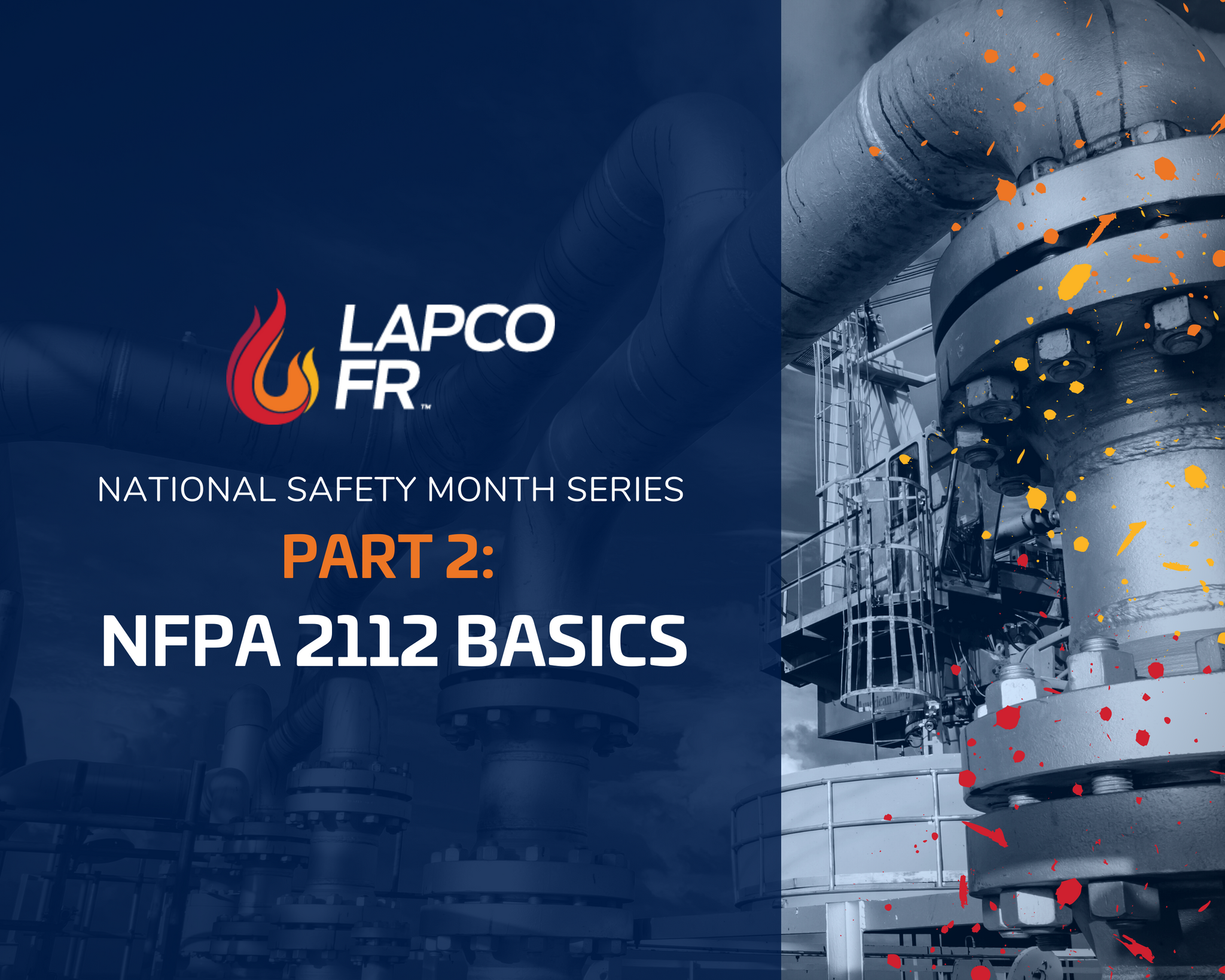While protecting against arc flashes in the industrial workplace is essential, they are not the only danger. Flashfire safety is just as important. In part two of the FR Safety Series, we will explore some of the basics of the NFPA 2112 standard.
FR Safety Standards Series: Part 2
The NFPA 2112 standard is the "Standard on Flame-Resistant Clothing for Protection of Industrial Personnel Against Short-Duration Thermal Exposures from Fire."
According to NFPA.org,
"The standard shall specify the minimum performance requirements and test methods for flame-resistant fabrics and components and the design and certification requirements for garments for use in areas at risk from flash fires."
"This standard shall provide minimum requirements for the design, construction, evaluation, and certification of flame-resistant garments, shrouds/hoods/balaclavas, and gloves for use by industrial personnel, with the intent of not contributing to the burn injury of the wearer, providing a degree of protection to the wearer, and reducing the severity of burn injuries resulting during egress from or accidental exposure to short-duration thermal exposure from fire."
NFPA 2112 compliant FR garments are designed to protect the people who wear them in hazardous work conditions. Fabrics, trims, and components are chosen, and the apparel is manufactured specifically to ensure they will not increase the extent of an injury by continuing to burn if ignited or melting onto the skin.
The following are some of the tests used when flame-resistant garments are being evaluated for certification as NFPA 2112 compliant.
|
PROTECTION FEATURE TESTED |
STANDARD TEST METHOD USED |
SPECIFIC REQUIREMENTS TO PASS |
|
Heat Transfer Performance (HTP) |
ASTM F2700 - Standard Test Method for Unsteady-State Heat Transfer Evaluation of Flame-Resistant Materials for Clothing with Continuous Heating |
HTP rating of 12.6J/cm2 (3.0 cal/ cm2) or more when measured in "contact," and 25J/cm2 (6.0 cal/cm2) or more when measured "spaced" Before and After Three Launderings |
|
Flame Resistance Test |
ASTM D6413 - Standard Test Method for Flame Resistance of Textiles (Vertical Test) |
4 in. Max. Avg. Char Length 2 s Max. Avg. After Flame No Melt & Drip Before & After 100 Launderings/Dry Cleanings |
|
Heat and Thermal Shrinkage Resistance Test |
ASTM F2894 - Standard Test Method for Evaluation of Materials, Protective Clothing, and Equipment for Heat Resistance Using a Hot Air Circulating Oven |
Heat Resistance - No Melting and Dripping, Separation, or Ignition Before and After Three Launderings or Dry Cleanings |
|
Thermal Shrinkage Resistance - 10% Maximum Shrinkage Before and After Three Launderings or Dry Cleanings |
||
|
Body Area Burn Injury Protection |
ASTM F 1930 - Instrumented Manikin Test Standardized Coverall |
Body Burn Prediction of 50% or Less One Laundering/Dry Cleaning |
|
Thread Heat Resistance Test |
ASTM D7138, Standard Test Method to Determine Melting Temperature of Synthetic Fibers. |
Must withstand temperatures of up to 260°C (500°F). If the melting temperature is less than 260°C (500°F), the thread fails the test. Room Temperature |
|
Label Print Durability Test |
Specimens shall be examined for legibility at a distance of 30.5 cm (12 in.) by the unaided eye with 20/20 vision, or vision corrected to 20/20, for legibility to determine pass/fail. |
Must be legible at a distance of 30.5 cm (12 in.) by the unaided eye with 20/20 vision, or vision corrected to 20/20. Before & After 100 Launderings/Dry Cleanings |
The tests above are not the only assessments considered when evaluating flame-resistant garments, shrouds, hoods, balaclavas, and gloves. These tests help establish the performance properties of the garments. Still, there are more properties to consider, such as Fabric Weight, Tensile Strength, Tear Strength, Material Burst Strength, Laundering Shrinkage, Laundering Colorfastness, Dry Cleaning Colorfastness, Crocking Colorfastness, Light Colorfastness, and Seam Efficiency. The evaluation methods for these properties are listed in Table B.1 of the NFPA 2112 standard.
NFPA 2112 also sets requirements for the contents of flame-resistant clothing labels.
Labeling Requirements:
- Manufacturer Label: States model name, number, or design, manufacturer's name, address, country of manufacture, serial number, size, fiber content, and "Do Not Remove" statement
- Compliance Statement: "THIS CLOTHING ITEM MEETS THE REQUIREMENTS OF NFPA 2112-2018. NFPA 2113 REQUIRES UPPER AND LOWER BODY COVERAGE"
- UL: Garments labeled as compliant with NFPA 2112 must meet or exceed all applicable requirements specified and shall be UL certified
- Label Print Durability: Legible at 12 inches after 100 launderings or dry cleanings
- Certification: Third-party compliance verification
- Additional Information: The label shall include the international symbol for "Read Instructions Before Use," and the manufacturer shall provide information on warnings, instructions for use, and sizing charts
- Care Label: Cleaning and care instructions (included in sister standard NFPA 2113)
You can learn more about the NFPA 2112 standard, access the standard for online reading, or purchase the standard here.
References listed below were accessed June 2022:
NFPA 2112 Standard on Flame-Resistant Clothing for Protection of Industrial Personnel Against Short-Duration Thermal Exposures from Fire
https://www.nfpa.org/codes-and-standards/all-codes-and-standards/list-of-codes-and-standards/detail?code=2112
Six Important Changes Reflected in NFPA 2112-2018 Updates.
https://ohsonline.com/Articles/2018/12/01/Six-Important-Changes-Reflected-in-NFPA-2112-2018-Updates.aspx

